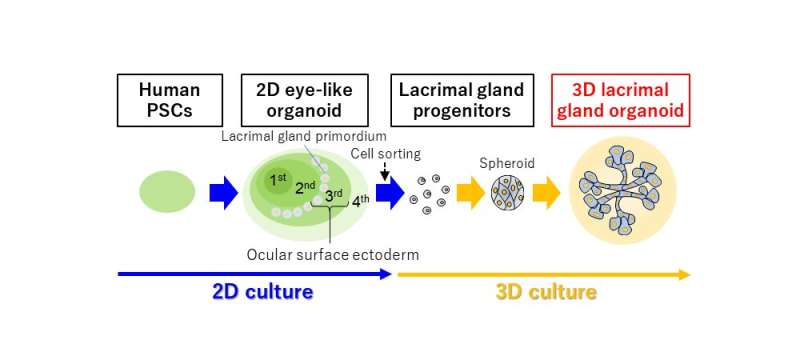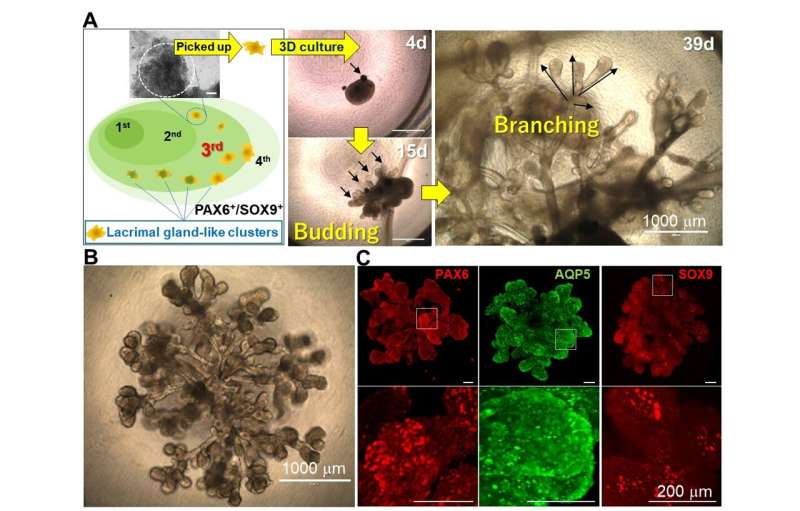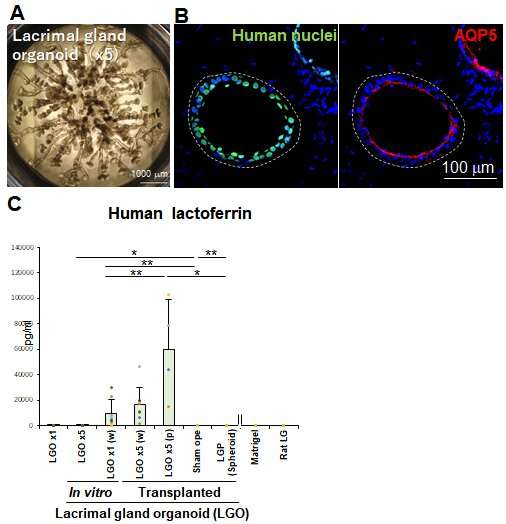Nothing to cry about: The development of tear duct organoids

Advancements in cell culture methods have allowed for the development of organoids—stem cell-derived mini-organs that mimic the tissue organization of our body. Now, researchers in Japan have developed a new organoid system that may bring tears of joy to people suffering from dry eye syndrome.
In a new study published in Nature, a research team led by Osaka University has demonstrated a method for the generation of three-dimensional (3D) human stem cell-derived organoids that model the tear duct (also known as the lacrimal gland). These lacrimal gland organoids exhibit organization and branching patterns characteristic of those observed in the human lacrimal gland during development.
Stem cells have the capacity to differentiate into any cell type of the body. When stem cells are grown in a culture format that promotes aggregation, treatment with a defined series of signaling molecules can guide stem cell differentiation and self-organization into organoids reminiscent of the body's organs. Researchers led by Osaka University previously developed a two-dimensional (2D) eye-like organoid using human induced pluripotent stem (iPS) cells and noted the presence of lacrimal gland-like cells in these organoids. The lacrimal gland, which is located inside the eyelid, is responsible for producing fluid that facilitates vision and protects the eye. Decreased tear production is associated with dry eye syndrome, which is a feature of a common autoimmune disease known as Sjögren's syndrome. The research team sought to explore the generation of lacrimal gland organoids, which may serve as a platform for the development of new therapies for the treatment of dry eye syndrome.

"To create lacrimal gland organoids, we first isolated lacrimal gland progenitor cells from our 2D human eye-like organoids," says lead researcher/first author Ryuhei Hayashi. "We found that further culture of this progenitor cell population, which expressed early markers of lacrimal gland development, resulted in the successful formation of 3D lacrimal gland organoids."
In addition to displaying organization patterns characteristic of the lacrimal gland, the organoids expressed key markers associated with lacrimal gland development. To explore the functional capacity of the organoids, the research team transplanted lacrimal gland organoids into rodents in which the lacrimal gland had been partially or fully removed.

"We were pleased to find that post-transplantation, the organoids demonstrated differentiation into mature lacrimal gland tissue," says last author Kohji Nishida.
The research team's method represents the world's first technology for the generation of 3D lacrimal gland organoids from human iPS cells. These lacrimal gland organoids may serve as a foundation for the development of regenerative therapies and drugs for the treatment of severe dry eye syndrome associated with Sjogren's syndrome and other disorders.
More information: Ryuhei Hayashi et al, Generation of 3D lacrimal gland organoids from human pluripotent stem cells, Nature (2022). DOI: 10.1038/s41586-022-04613-4




















